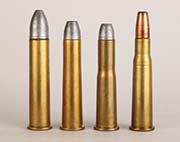Elric
Well-Known Member

The .45-70’s Offspring - GUNS Magazine
Our Military Cartridges Always Inspire Much Experimentation, And The First To Do So Was The .45 Gov’t. By Mike “Duke” Read the full article...
" Because of heavy recoil in the 7-pound “trapdoor” cavalry carbines another version was soon being loaded by the government. It held a reduced charge of 55 grains black powder with the same 405-grain bullet. Hence it was known as the .45-55-405. A good question here is what did the government loaders do to take up the extra air space, since loose charges of black powder gave less consistency than compacted ones. A cardboard tube inserted inside the cartridge case was filled with the powder charge. The tube stayed put upon firing. In fact, archaeologists have recovered fired cartridge cases at the Little Bighorn Battlefield with the tubes intact. "
Guns Magazine, May 2010, page 54
"Therefore, a special reduced load was developed for them holding only 55 grains of black powder. The extra space was taken up by a cardboard tube slipped down inside the case before bullet and powder were loaded."
Archaeological Perspectives on the Battle of the Little Bighorn
Archaeological Perspectives on the Battle of the Little Bighorn
Ever since the Custer massacres on June 25, 1876, the question has been asked: What happened - what REALLY happened - at the Battle of the Little Bighorn? We know some of the answers, because half of George Armstrong Custer’s Seventh Cavalry - the men with Major Marcus Reno and Captain Frederick...
books.google.com
Snap. read a post that suggested the tube was used in copper cases, with the switch to solid head, they went to wads, then just seated the bullet deeper. My guess at this point, the tube made sense in the flat bottomed balloon head, and when the base of the solid heads were tapered, it was not good to prevent powder from ejecting the tube.
Last edited:
